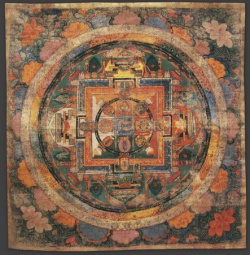The 8th Karmapa on Faith
The 8th Karmapa, Mikyö Dorje, upon being invited to Drikung by the 18th throne holder Rinchen Namgyal (1519-1576, reg. 1534-1565), spent there one year (1536-37) together with his famous “secretary,” the great historian and 2nd Pawo Rinpoche, Tsuglag Trengwa (1504-1566).
During this time, he studied and extensively taught Jigten Sumgon’s Gongchik, which he saw as the tenet’s of the Kagyüpas.
Later (1544-46), using his own notes and the notes of Tsuglag Trengwa, he wrote several texts which are nowadays collectively known as the 8th Karmapa’s commentary of the Gongchik.
Here I would like to present a very brief excerpt from his comments upon vajra-statement 6.6, which teaches that guru devotion is the only means for obtaining realisation.
In this excerpt, the Karmapa explains the Buddhist notion of faith (Tib. dad pa). He says:
“The Ratnolka says:
If you have faith in the Victor and the Victor’s teachings,
faith in the teachings of the Victor’s sons,
and faith in supreme awakening,
that is the arising of the resolve of great beings.
And the Shikshasamuccayakarika says:
Make the root of faith stable and make the mind the support for awakening.
What kind of faith is that? The Abhidharmasamuccaya says:
What is faith? It is the firm conviction (mngon par yid ches pa), admiration, and aspiration with regard to what exists and is endowed with [good ] qualities and abilities.
Its has the function of forming the basis for striving.
Thus, ‘what exists’ are the causes and results of the five skandhas such as ‘action and result’ and ‘suffering and the origin [of suffering].’
‘What is endowed with [good] qualities’ are the Three Jewels.
‘Abilities’ is the truth of cessation, [namely] the thought: ‘I am able to obtain cessation; I am able to cultivate the path in my mental continuum.’
Because of the faith of conviction [that understands] ‘action and result’ and ‘suffering and the origin [of suffering]’ as infallible, and
since the Three Jewels that are free from the faults of ‘suffering and [its] origin,’ etc., are without all defects and endowed with all
[good] qualities, by cultivating [[[faith]]] in their presence, the small hairs of the body are standing on end and tears flow [from one’s eyes], etc.
[That is] the faith of admiration. The aspiration to obtain cessation and the aspiration to cultivate the path in the mental continuum are ‘the faith of aspiration.’
Now, if, first, there [arises] admiration from seeing and hearing about the qualities of the Supreme Jewels, and from that the aspiration to
obtain their qualities, and if one is convinced that the faults that veil those qualities are faults, that forms the basis that is the
function of causing all faults and defects to be abandoned. [All that] is faith.”
Notes
The 17th Karmapa recently re-published the 8th Karmapa’s commentary: http://www.dharmadownload.net/karmapa/08_Karmapa/8th%20Karmapa%20pages/07_8th_Karmapa_text_DrigungGongchig/07_00_00_8thKarmapa_DG_index.htm
The excerpt is taken from the second part (smad cha) of ‘Jig rten gsum gyi mgon po ‘bri gung pa chen po’i dam chos dgongs pa gcig pa’i kar TIka las/ tshoms dang po’i rnam bshad karma bka’ brgyud kyi mkhyen pa rab gsal bka’i me long mchog tu ‘bar ba bzhugs so//
1. [These lines are actually from the Arya Ratnolka Namadharani Mahayanasutra (‘Phags pa dkon mchog ta la la’i gzungs zhes bya ba theg pa chen po’i mdo), D vol. 57, fol. 63v (variants in bold): rgyal dang rgyal ba’i chos la dad gyur cing // sangs rgyas sras kyi spyod la dad byed la// byang chub bla na med la dad gyur nas// skyes bu chen po rnams kyi sems skye’o//.
Sonam Spitz informed me that according to Shakya mchog ldan (brDa’i gnas bye brag tu rtogs ces bya ba’i tshig leu byas pa, p. 378, vol. 24/ya, TBRC-no WG00WGS1016899), “dKon mchog ta la la” is just a bad translation of the Sanskrit title “Ratnolka”, which indeed reads correctly “dKon mchog sgron me” in Tibetan. Thus, the “Ta la la” is in fact the Ratnolka.]↩
2. [Shikshasamuccayakarika, D vol. 111, fol. 1v (variants in bold): dad pa’i rtsa ba brtan bya ste// byang chub la yang blo brtan bya//. In the Shikshasamuccaya, these lines are followed by the quote preceding in the present text.↩
3. [[[Abhidharmasamuccaya]], D vol. 134, fol. 48v: dad pa gang zhe na/ yod pa nyid dang / yon tan can dang / nus pa rnam la mngon par yid ches pa dang / dang pa dang ‘dod pa ste/ ‘dun pa’i rten byed pa’i las can no//.
